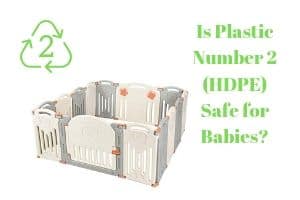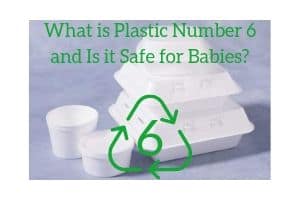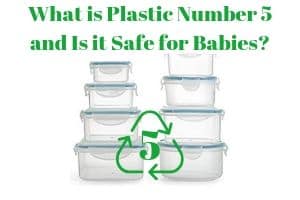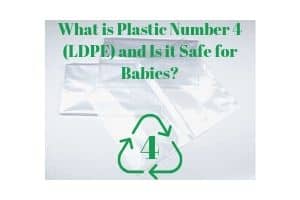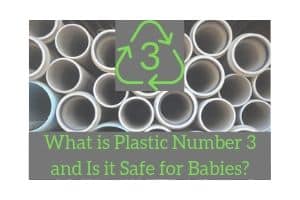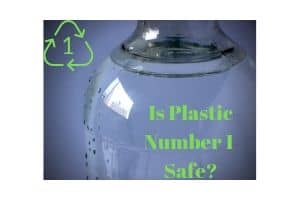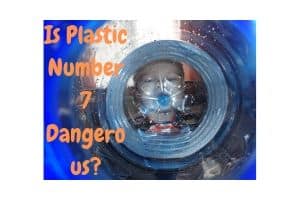It’s nearly impossible to avoid plastics in the modern world and it can be quite confusing trying to figure out which types of plastic are safe and which can be harmful. With that in mind, I’m tackling all of the plastic numbers you’re likely to find on packaging and today we’re looking at plastic number 2 to see what it is and whether or not it’s safe for babies.
Plastic number 2 (High-density polyethylene or HDPE) is considered one of the safest plastics in use today and it won’t leach harmful chemicals into food or beverages. It is easily recyclable and it can be found in items such as milk jugs and baby furniture.
Fortunately, some plastics are pretty safe when it comes to the health of your baby. Let’s dive into what exactly number 2 plastic is, where you will find it, and the overall safety profile for your baby.
Table of Contents
What does plastic number 2 mean?
You’ve probably seen the triangular arrow symbol on the bottom of plastic bottles and containers and weren’t sure what it meant. These numbers are actually called resin identification codes (RIC) and they are there to inform recyclers what type of plastic the item is made from so they will know what to do with it once it reaches their facility. The bonus is that consumers will be able to learn what their products are made from as well. By the way, just because you see the symbol for recycling doesn’t mean that it can be recycled!
Plastic items with the number 2 on the bottom are made from high-density polyethylene, or HDPE, which is a thermoplastic that is petroleum-based. It’s a very hard, durable, and light plastic that is prized for its ability to hold or support much more than its weight would suggest. It’s usually opaque and colored during the manufacturing process. It’s also one of the most recycled plastics in the US with about 30 to 35 percent of the HDPE produced finding its way to other uses.
There are seven different categories of plastic and the standard for these is maintained by the American Society for Testing and Materials (ASTM International). Although it might seem like the standard should exist to educate consumers, there is actually no regulating body in the US that forces manufacturers to use these codes or to provide specific information about their materials in most cases. Essentially, the symbols are put on things voluntarily to help get them recycled. That’s why you are unlikely to find these symbols on anything other than food or beverage containers.
Examples of plastic number 2
Because of it’s safety and versatility, you’ll find HDPE in many products on the market today. In addition to being food-safe, it is also resistant to bacterial growth, extreme temperatures, and sunlight. You’ll find this plastic in:
- Picnic tables
- Waste bins
- Park benches
- Truck bed liners
- Plastic lumber (such as raised garden beds)
- Grocery store bags
While safe, the biggest drawback of number two plastic is that some of the products create an environmental hazard if they aren’t disposed of properly. There has been a lot of recent news about plastic bags accumulating in waterways and even being eaten by wildlife. Both of these problems are serious issues for the overall health of the earth and its population!
Food containers made from HDPE
The perfect example of a food container made from HDPE is your standard milk jug. Even though the jug itself only weighs a couple of ounces, it can easily hold a gallon of milk without coming apart!
You’ll also find this material in bottles of juice, chocolate syrup, and vinegar. It’s also common in squeeze bottles for certain foods. It’s 100% approved for food contact by the FDA. While you could clean and reuse these containers, they are generally recommended as single-use when dealing with food and beverage.
Baby products made from HDPE
While you probably won’t find many cups or multi-use food-related baby products made from number 2 plastic, you are much more likely to find it inside your baby’s playroom.
Because it’s so tough and durable, many manufacturers choose this product for baby toys and accessories like:
- bookshelves
- chairs
- tables
- colorful storage containers
- toy cars and trucks (including ride-ons)
The benefit of using HDPE for baby products is that they are light, durable, and easy to clean. Your daughter will be able to move around her table and chairs the way she wants. Your son will be able to throw his trucks down the stairs and not have to worry about breaking them. It also works great for outdoor playground equipment like slides, water tables, and swings.
Another common baby item frequently made with HDPE is a baby gate or pen. We personally like to have a playpen set up for our infant son inside the larger playroom because we don’t want him getting into his sisters’ toys which are quite small and present a choking hazard. In this case, we recommend a foldable and customizable playpen like this one. It has fun colors, safe hinges that avoid pinching baby fingers, and it’s sturdy enough to stand up to a toddler’s rough playstyle!
Is plastic number 2 safe for babies?
As I’ve mentioned, HDPE is considered very safe for babies due to its chemical stability. It is very unlikely to leach chemicals into food or beverages and doesn’t pose a risk for your baby even if its stored for long periods or exposed to warmer temperatures.
I personally wouldn’t worry at all if any of my baby’s food containers or toys were made from HDPE.
Importantly, you won’t find any BPA or phthalates inside plastic number 2 because they aren’t used in the manufacturing process. When it comes to plastics, these are usually the biggest culprits for compromised safety. Since it’s not an issue, don’t be surprised or alarmed if you don’t see the BPA free designation on something made from HDPE.
Using plastic alternatives for your baby
Even if it’s safe, there are still downsides to using HDPE and plastic in general. Since it’s made from petroleum, you have all of the various by-products of that industry to consider as well as the huge negative impact that plastics, in general, make on our environment. While recyclable, most of the plastic purchased by consumers finds its way into landfills or waterways. In a landfill, plastic takes thousands of years to decompose and marine wildlife can be poisoned or killed by plastic trash floating in their homes.
To avoid plastic altogether, consider using stainless steel food and beverage containers along with wooden baby toys and accessories.
Stainless steel cups
If you are looking to replace your plastic bottles and sippy cups, I highly recommend this starter kit from Pura Stainless available on Amazon. It comes with two each of their stainless bottles, silicone slow flow nipples, medium flow nipples, XL sippers, travel covers, and seals. For a decent price, you’ll have a system that you can use over and over again as it grows along with your baby from birth through the toddler years.
Wooden baby toys and teethers
While many baby toys on the market are made from plastic, there are a ton of wooden alternatives available as well that work just as well. The added benefit to wooden toys is that they are extremely durable and look nice and classy as well! One of our favorites is this wooden baby rattle/teething ring combo available on Amazon. It’s cheap and only uses 100% non-toxic paints, dyes, and sealers. It’s also made from ethically harvested wood!
Learn about the other plastic numbers
Now that we’ve covered the details of number 2 plastic (HDPE), you might want to check out the next article on the baby safety of plastic number 3 (PVC). It’s known as the poison plastic so learn all about why it’s dangerous and how to avoid it!

